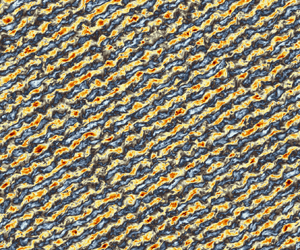Article contents
The decay of stably stratified grid turbulence in a viscosity-affected stratified flow regime
Published online by Cambridge University Press: 08 August 2022
Abstract

The decay of stably stratified turbulence generated by a towed rake of vertical plates is investigated by direct numerical simulations (DNS) of temporally evolving grid turbulence in a linearly stratified fluid. The Reynolds number  $Re_M=U_0M/\nu$ is 5000 or 10 000 while the Froude number
$Re_M=U_0M/\nu$ is 5000 or 10 000 while the Froude number  $Fr_M=U_0/MN$ is between 0.1 and 6 (
$Fr_M=U_0/MN$ is between 0.1 and 6 ( $U_0$: towing speed;
$U_0$: towing speed;  $M$: mesh size;
$M$: mesh size;  $\nu$: kinematic viscosity;
$\nu$: kinematic viscosity;  $N$: Brunt–Väisälä frequency). The DNS results are compared with the theory of stably stratified axisymmetric Saffman turbulence. Here, the theory is extended to a viscosity-affected stratified flow regime with low buoyancy Reynolds number
$N$: Brunt–Väisälä frequency). The DNS results are compared with the theory of stably stratified axisymmetric Saffman turbulence. Here, the theory is extended to a viscosity-affected stratified flow regime with low buoyancy Reynolds number  $Re_b$, and power laws are derived for the temporal variations of the horizontal velocity scale (
$Re_b$, and power laws are derived for the temporal variations of the horizontal velocity scale ( $U_H$) and the horizontal and vertical integral length scales (
$U_H$) and the horizontal and vertical integral length scales ( $L_H$ and
$L_H$ and  $L_V$). Temporal grid turbulence initialized with the mean velocity deficit of wakes exhibits a
$L_V$). Temporal grid turbulence initialized with the mean velocity deficit of wakes exhibits a  $k^{2}$ energy spectrum at a low-wavenumber range and invariance of
$k^{2}$ energy spectrum at a low-wavenumber range and invariance of  $U_H^2L_H^2L_V$, which are the signatures of axisymmetric Saffman turbulence. The decay of various quantities follows the power laws predicted for low-
$U_H^2L_H^2L_V$, which are the signatures of axisymmetric Saffman turbulence. The decay of various quantities follows the power laws predicted for low- $Re_b$ Saffman turbulence when
$Re_b$ Saffman turbulence when  $Fr_M$ is sufficiently small. However, the decay of
$Fr_M$ is sufficiently small. However, the decay of  $U_H^2$ at
$U_H^2$ at  $Fr_M=6$ is no longer expressed by a power law with a constant exponent. This behaviour is related to the scaling of kinetic energy dissipation rate
$Fr_M=6$ is no longer expressed by a power law with a constant exponent. This behaviour is related to the scaling of kinetic energy dissipation rate  $\varepsilon$, for which
$\varepsilon$, for which  $\alpha =\varepsilon /(U_H^3/L_H)$ is constant during the decay for
$\alpha =\varepsilon /(U_H^3/L_H)$ is constant during the decay for  $Fr_M\leq 1$ while it varies with time for
$Fr_M\leq 1$ while it varies with time for  $Fr_M=6$. We also examine the experimental data of towed-grid experiments by Praud et al. (J. Fluid Mech., vol. 522, 2005, pp. 1–33), which is shown to agree with the theory of low-
$Fr_M=6$. We also examine the experimental data of towed-grid experiments by Praud et al. (J. Fluid Mech., vol. 522, 2005, pp. 1–33), which is shown to agree with the theory of low- $Re_b$ Saffman turbulence.
$Re_b$ Saffman turbulence.
- Type
- JFM Papers
- Information
- Copyright
- © The Author(s), 2022. Published by Cambridge University Press
References
- 6
- Cited by



